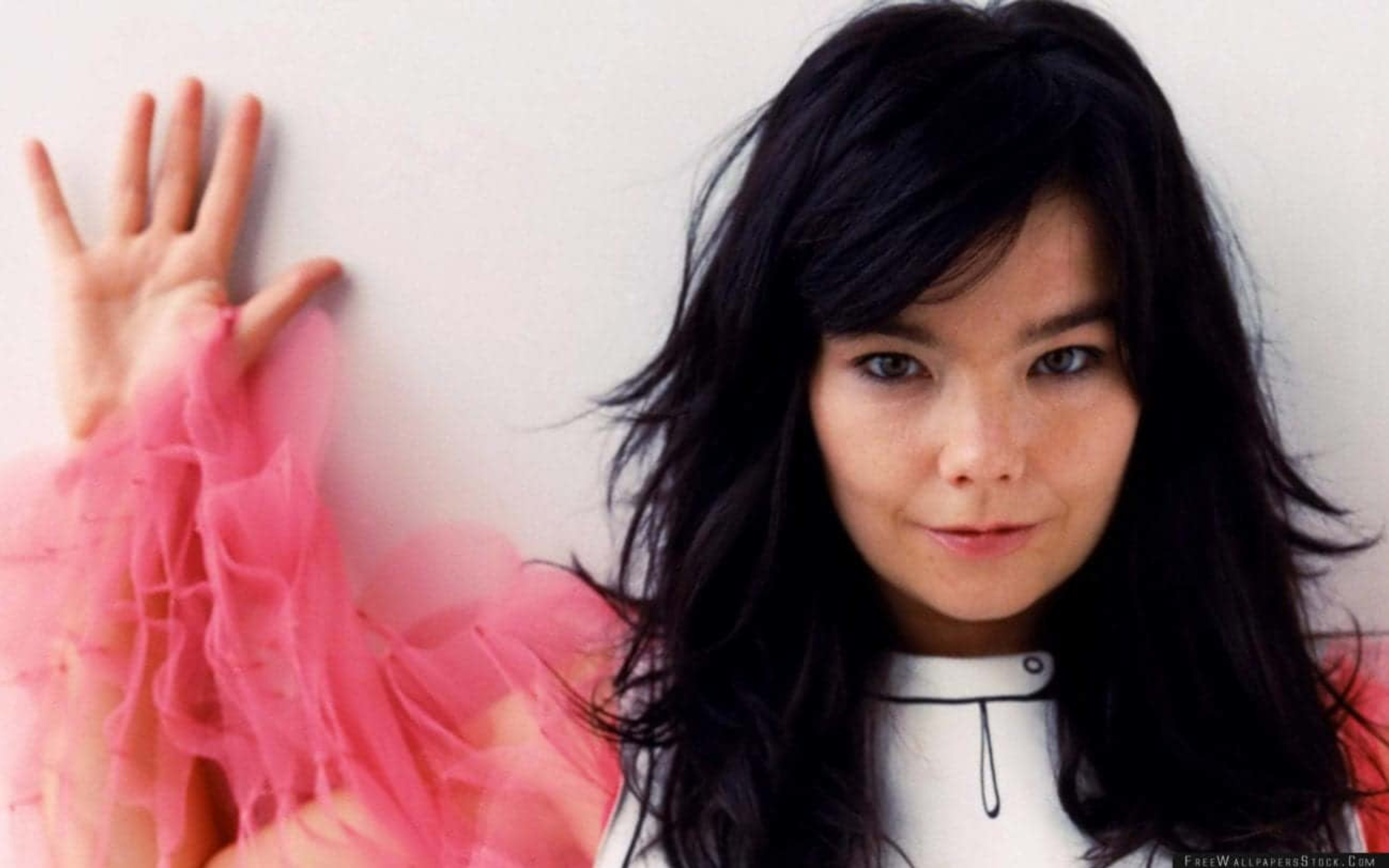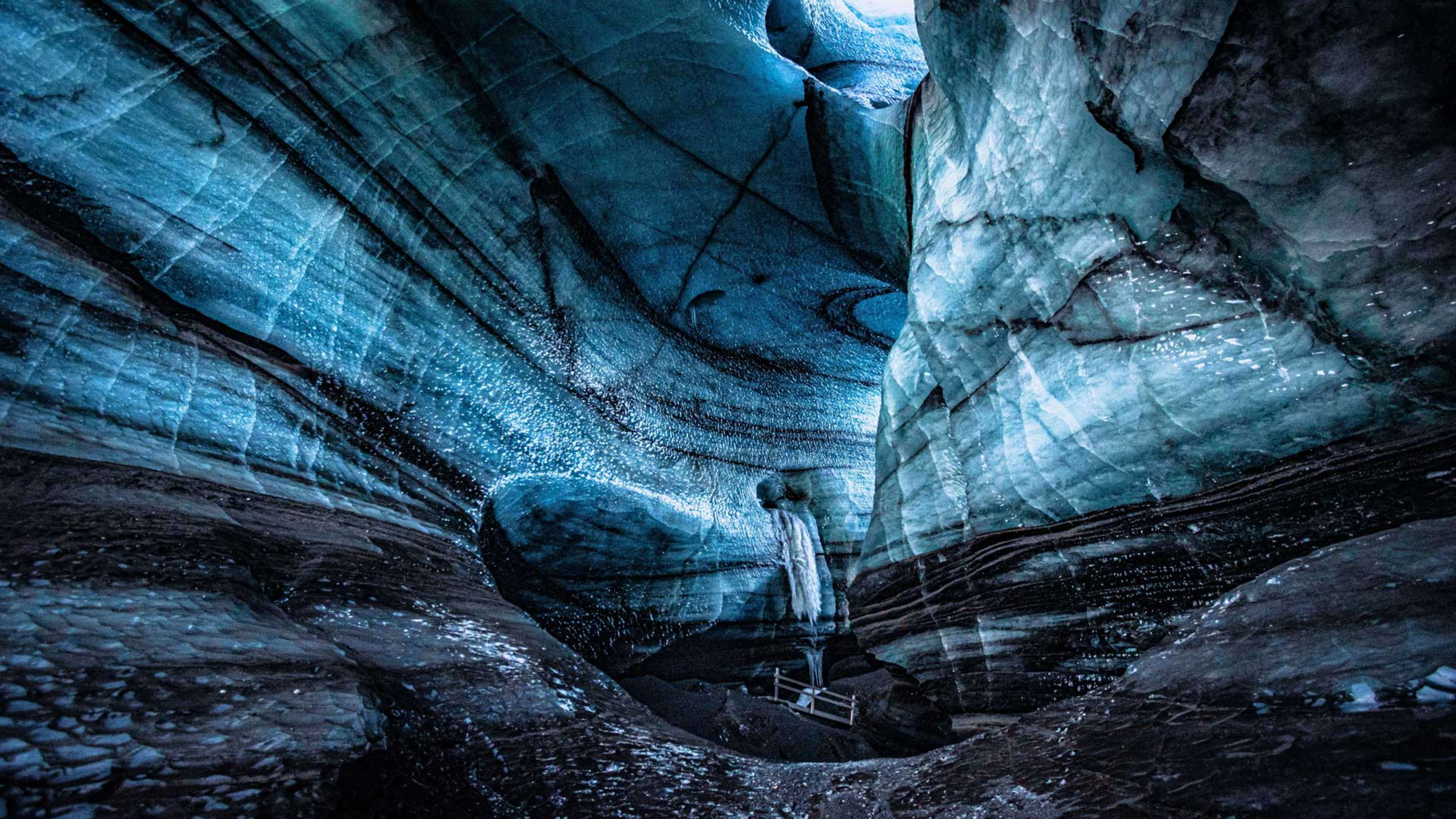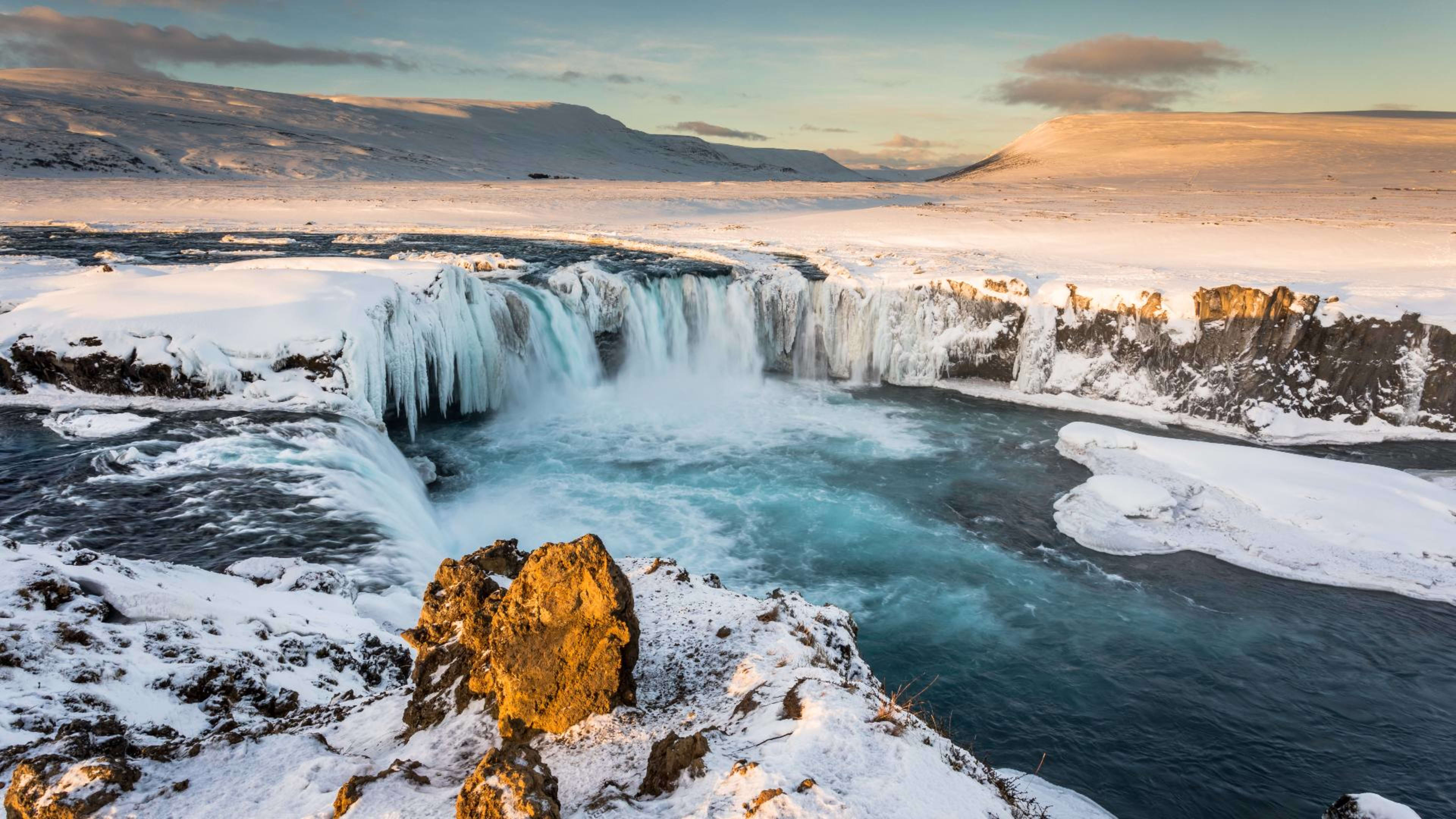Björk was Iceland’s first celebrity to truly achieve overseas fame. However, Björk Guðmundsdóttir, as she is called by her full name, is by every definition, an icon of the Icelandic cultural scene. In her unique, quirky, and unapologetic way she has charmed the world and she is nowhere close to retiring.
The short version of her life and career is captured in this video, but stick around if you want some deeper knowledge!
- See the nature that inspired Björk on an Iceland adventure trip.
Björk, the early years
Björk was born on 21 November 1964 in the capital of Iceland, Reykjavík. Her parents, Guðmundur (union leader and electrician) and Hildur Rúna (activist) divorced early in her life and she went on to live with her mother in a commune.
Her stepfather was a guitarist in a band called Pops, so music was surely a part of her upbringing. At the age of six, Björk was enrolled in a music school for children where she studied classical piano and the flute thus marking the beginning of her music career.
Where it all began
At one of the school’s recitals, Björk was recorded singing by her teacher. Luckily, this teacher then sent in the tape to the leading radio station in Iceland. So, the recording of Björk singing was broadcast nationally.
Eventually, she landed a recording contract which led to her self-titled début album Björk. The album was recorded when she was 11, but released in December 1977. Björk contained famous Icelandic children songs sung by Björk.
Björk, the teen
From lighthearted children’s music, the ever so cool 14-year-old Björk formed an all-girl punk band, called (in English) Spit and Snot. And, the following year she would not only start a new band, this time a jazz fusion group called Exodus, but also graduate from music school.
In 1982, Björk and bassist Jakob Magnússon formed the group Tappi Tíkarrass which roughly translates in English to ‘Cork Bitch’s Ass’ – never a dull moment in linguistics.
The group was later featured in the documentary Rock in Reykjavík, where a famous photo of Björk in a yellow dress was used for the cover.
Fun Fact: You can actually find this cover sold as a poster in many of the local tourist and book shops downtown!
Björk, the young adult
Rokka Rokka Drum was the next group that Björk formed. This was the first time Björk had worked with poet Sjón, whom she had long known and shared a close friendship. Around the same time, she met guitarist Þór Eldon, who she would later date and who fathered her son.
It was right around this time that Björk started to develop the vocalization she is still known for today: the howls and high-pitched shrieks.
But where did her signature sound come from? A radio show in Iceland called Áfangar was suddenly cancelled. To celebrate the end of the show with a bang, a few artists were asked to play the final live show.
Björk, Einar Melax, Einar Örn Benediktsson, Sigtryggur Baldursson, Guðlaugur Óttarsson, and Birgir Mogensen played the gig. Together, on this night, they developed a gothic rock sound. They played so well together, they decided to continue playing together as a group using the name Kukl (meaning sorcery in Icelandic).
Kukl, the band
Kukl released their first single in 1983, followed by a performance a music festival in Iceland headlined by the English anarchist punk band Crass. The headlining band loved Kukl’s act and their record label, Crass Records offered the band a record deal.
Furthermore, the following year the album The Eye was released leading to a 2-month tour around Europe where Kukl performed at the famous Roskilde festival in Denmark, becoming the first Icelandic band ever to play that gig.
The following year, Björk discovered she was pregnant. She continued touring, but the band eventually split up. Subsequently, Björk and Þór Eldon got married in 1986 and welcomed their son Sindri into the world a little later.
The Sugarcubes
In the summer of 1986, Einar Örn and Björk’s then-husband Þór Eldon formed the art collective Smekkleysa or ‘Bad Taste’ as it was called in English. The plan for it was to be both a record label and a book publishing company and old friends came in to take part.
As time went by, the Kukl band was half-reestablished and they started playing again. At one of their earlier performances the band, however, started referring to themselves as the Sugarcubes or Sykurmolarnir in Icelandic and it stuck. That was to become the beginning of something big!
As time went by, the Kukl band was half-reestablished and they started playing again. At one of their earlier performances the band, however, started referring to themselves as the Sugarcubes or Sykurmolarnir in Icelandic and it stuck. That was to become the beginning of something big!
On a personal level, Björk and Þór had divorced but kept working together.
The Sugarcubes go abroad
On Björk’s 21st birthday, they released their first 2 songs and by the end of that year they were already signed. They translated one of their first singles, Afmæli, and on 17 August 1987 it was released in the UK under the name Birthday. The following week it would win single of the week by Melody Maker. By 1988, the Sugarcubes were signed in the US and their they recorded their first album Life’s Too Good.
The album sold well and the Sugarcubes toured North America and received tons of positive feedback. The band even went on to appear on Saturday Night Live.
Sadly their following album Here Today, Tomorrow Next Week didn’t turn out to be as successful and Björk started working on her solo stuff. She had by this time decided to leave the band but was bound by contract to finish the third album and follow it up with a tour.
She held her end of the deal and Stick Around for Joy came out in 1992. Although not long-lived, Rolling Stone called the Sugarcubes the biggest rock band to emerge from Iceland.
Björk goes solo
Some of Björk’s first solo work was for Sódóma Reykjavík which would later prove to be somewhat of an Icelandic cult movie. She was featured on 2 songs on the soundtrack.

She also took on some background vocals, but one of her best-selling albums in Iceland is still a jazz collective album she collaborated on with Tríó Guðmundar Ingólfssonar called Gling-Gló.
However, around this time Björk’s interest in house music also came about when she contributed vocals on the 808 State’s album Ex:el. In the same year, she met harp player Corky Hale whim whom a recording session would spark her future album Debut.
Björk moves to London
In 1993, she began working with producer Nellee Hooper who was, amongst others, famous for producing Massive Attack. Their collaboration birthed Björk’s first international solo hit Human Behaviour. It didn’t receive loads of radio time but it did gain a lot of airtime, especially on MTV.
The video was directed by Michel Gondry and they were to work a lot together in the following years.
Björk’s first solo album
Björk’s first solo album Debut came out in June 1993 and was named Album of the Year by NME, eventually going platinum in the US. The album had some personal songs for Björk, many of which she has written as a teenager. It varied greatly in instrumentation yet maintained a dancy rhythm throughout.
Tracks include:
- ‘Venus as a Boy’
- ‘Like Someone in Love’
- ‘The Anchor Song’
Björk, the award-winning artist
The following year, Björk was greatly awarded at the Brit Awards, winning Best International Female and Best International Newcomer. Her acknowledgement led to some seriously high-profile collaborations. She worked with David Arnold on the song ‘Play Dead’ for the film The Young Americans and later appeared on tracks for Plain before co-writing the song ‘Bedtime Story’ for none other than Madonna!
Björk’s next album was released in June 1995 and was called Post. She collaborated with some new artists for this project, which you can see in some of the work as trip-hop and electric sounds start to show on tracks like ‘Possibly Maybe’ and ‘Enjoy’. This is said to have been influenced by Howie B, Tricky, and her old friend Graham Massey.
The album was a total hit, landing a place on any top album list during that time. Reaching its height in 2003, when the album was ranked at 373 on Rolling Stone magazine’s list of the 500 greatest albums of all time. Not too shabby!
Perhaps, the most famous song on Post.
1997 and onwards
Björk’s next album Homogenic was released in 1997. This album marked a noticeable shift in style and never before had she been this personal, emotional, and experimental, which many would still say was her style. Some of the beats on the album are thought to reflect the landscape of Björk’s home country Iceland very visible in the song ‘Jóga’.
The album reached gold in the US in 2001. And contained songs like:
- ‘Bachelorette’
- ‘All Is Full of Love’ (first music video ever to be released on DVD)
The musical trial
In 1999 Björk, was accepted to write and produce the score the musical-film Dancer in the Dark. The film was directed by Lars Von Trier who after a lot of effort, managed to convince Björk to take on the leading role of Selma. The film debuted at the 53rd Cannes Film Festival and received the Palme d’Or with Björk receiving the Best Actress Award for her role. She was later quoted as saying this would be the only musical she would ever do.

The soundtrack, however, went even further and was released with the title Selmasongs. One of the songs on the album ‘I’ve Seen It All,’ which was a duet with Radiohead’s Thom Yorke, went on to be nominated for an Academy Award and was performed at the 2001 Oscars. This is when Björk famously showed up wearing her legendary, Marjan Pejoski’s Swan Dress.

Björk in the early 2000s
In 2001, Björk released yet another album, her fastest-selling album to date, selling 2 million copies in one year. The album is called Vespertine.
This was her biggest project yet, bringing in artists from a wide spectrum and needing acoustics at the highest level for her subsequent shows. The album featured chamber orchestras, hushed vocals, harpists, DJs, choirs, household-made micro beats, and personal, vulnerable themes.
The album consisted of songs such as:
- ‘Hidden Place’
- ‘Pagan Poetry’
- ‘Cocoon’
During the tour of the album, Björk was accompanied by Matmos, Parkins, and perhaps, most surprisingly, an Inuit choir, who she had traveled to Greenland to audition.
In 2002, the CD box set Family Tree was released. It consists of selected rare material which had never-seen-before compositions, including her work with the Brodsky Quartet.
Alongside it she also released a greatest hits album. Those songs were carefully chosen through a fan pool on Björk’s website and a DVD collection of all her solo music videos!.
In late 2002, Björk gave birth to daughter Ísadóra Bjarkardottir Barney. She is the daughter of Björk and Matthew Barney an American contemporary artist and director. They were together from 2000–2013.
Medúlla
In 2004, the Medúlla album was released. Björk originally intended the album to be completely vocal-based album, working with artists like throat singer Tanya Tagaq, beatboxer Rahzel, beatboxer Dokaka, avant-rocker Mike Patton, Robert Wyatt, and several choirs, but eventually led instruments into the production. The album received a Grammy nomination.
Later that year, Björk performed ‘Oceania’, specially written for the occasion at the 2004 Summer Olympics in Athens. As she sang, her dress slowly started spreading out revealing a 10,000 square foot map of the world. The map then blew over all the athletes competing creating a magical moment at the opening ceremony.
Songs to appear in the following months were, ‘Triumph of a Heart’ and ‘Where Is the Line’.
2005 to 2010
In 2005, Björk and then-partner Matthew Barney collaborated on an experimental film. This was Björk’s second film at the time, called Drawing Restraint 9.
Through the film they explored Japanese culture and in the couple turn into whales. Björk also did the film’s soundtrack.
This was quite the film year for Björk but she additionally appeared in the documentary Screaming Masterpiece, which delves into the Icelandic music scene. In it clips of the Sugarcubes, Tappi Tíkarrass, and interviews with Björk are displayed.
Right around this time, Björk was, for the second time, the winner of the Best International Female Solo Artist at the Brit Awards. She was also awarded the Inspiration Award at the Annual Q Magazine Awards, an honor which she accepted from Robert Wyatt, who she had collaborated on Medúlla with.
Volta
In 2007, Björk released Volta, a full-length studio album ranging the whole spectrum. It consisted of inputs from artists like hop hip produced and ‘The Way I Are’ star, Timbaland, singer Anohni, poet Sjón (with her in the Sugarcubes), kora master Toumani Diabaté, electro beat programmer Mark Bell, an all-female Icelandic choir, and pipe player Min Xiaofen. Volta was Björk’s first album to reach the top 10 in the US, but also reached number 3 in France and 7 in the UK.
Some of the best recognized songs from the album:
- ‘Earth Intruders’
- ‘Innocence’
- ‘Declare Independence’
- ‘Wanderlust’
- ‘The Dull Flame of Desire’
The next release we saw from Björk was quite the original one. It was announced by an eBay auction. It was a new track named Náttúra (‘Nature’) and was intended to ‘encourage active support for a more environmental approach to Iceland’s natural resources’, reflecting Björk’s longstanding environmental activism.
Björk from 2010
In June 2010, Björk, in collaboration with Dirty Projectors, announced that they would be creating a joint EP, called Mount Wittenberg Orca, intended to raise money and awareness for marine conservation. Later that year she released ‘Comet Song’ which featured on the Moomins and the Comet Chase soundtrack.
The same year Björk collaborated with fellow Icelander Ólöf Arnalds on a song called ‘Surrender’.
On 7 December 2010, she released a song called ‘Trance’, which she had been keeping for some time. It was also a backing track of a short film made by artist Nick Knight, titled ‘To Lee, with Love’, as a tribute to McQueen. Björk collaborated with him on multiple occasions.
Biophilia
In 2011, Björk released Biophilia and managed to surprise everyone with her originality and creativity. The album was much more than just an album, it combined music with technological innovation and themes of both nature and science.
It was the world’s first app album and each song had its own app to be downloaded. In 2014, they were made permanent in the MoMA in New York.
The project also entailed an educational collaborations with specialized workshops for school children aged 10–12, bringing together music and science. The program was eventually bought by the Reykjavík City Board of Education to all schools in the city over the following three years.
Biophilia toured for 2 years and included songs such as:
- ‘Crystalline’
- ‘Cosmogony’
- ‘Virus’
- ‘Moon’
In 2013, Björk was featured alongside Sir David Attenborough in a Channel 4 documentary called when Björk met David Attenborough. They discussed the human relationship with music putting the main focus on Biophilia.
Björk now
The next album to come from Björk was Vulnicura, made in workmanship with Arca and Haxan Cloak. This was Björk’s ninth album.
Tragically, the supposed full version of the album leaked 2 months before only days after being announced. In an effort to salvage the loss in sales and publicity, and to make sure the fans got the proper quality version, it was made available worldwide on iTunes.
This invasion was probably even more personal since the album was Björk’s chronicle of her break-up with Matthew Barney.
- ‘Black Lake’
- ‘Mouth Mantra’
- ‘Stonemilker’
Björk at MoMA
In 2015, New York’s Museum of Modern Art hosted an exhibition covering Björk’s career from Debut to Biophilia. Although this hadn’t been previously announced, some parts of Vulnicura were included.
On 2 October 2015, Vulnicura Strings was announced. The album was an acoustic version of the previous hit record. It featured additional string arrangements plus the viola organista, a unique string instrument played on a keyboard designed by Leonardo da Vinci.
Moreover, only a week later the live version was announced on a double CD/LP set, but that it would be sold exclusively through Rough Trade record shops. It sold out in five days. Each format is limited to 1,000 copies each, making it one of the rarest physical releases of her recent career.
Vulnicura went on to be nominated for a Grammy Award.
Björk Digital
In June 2016, Björk opened the Björk Digital virtual reality exhibition in Sydney, Australia. The exhibition showcases all the virtual reality videos completed for Vulnicura so far. It was also the world premiere of Notget.
Björk made the exhibition into immersive visual worlds using 360-degree cameras, drones, and 3D printing. Subsequently, this is also around the same time she started using custom-made masks more. Here‘s a fantastic video with the mask-maker James Merry.
She DJed the opening night in Sydney, returning to Tokyo for the same show. During her time in Tokyo, Björk made world history by featuring in the first-ever virtual reality live stream via YouTube.
Additionally, Björk gave a live performance of the Vulnicura song ‘Quicksand’, with the footage being incorporated into the ‘Quicksand’ VR experience.
Björk Digital has traveled around the world, making stops in London, Montreal, Barcelona, Los Angeles, and Houston.
Björk the activist
In 2017 Björk once again used her music to put the focus on important issues when she announced a special box set of 7 records would be launched to support Planned Parenthood.
It featured a wide range of musicians, visual artists, comedians, and authors, all of whom have contributed new, previously unreleased or rare material.
Utopia
In 2017, Utopia hit the market again working with Acra on its production. Funnily, Björk has described it as her Tinder (dating app) album, alluding that the one before was her heartbreak album. By the same token, the album was completely different from any other. Decorated with flautists and Björk even playing the flute herself.
The album was nominated for the Best Alternative Music Album, making it Björk’s fifteenth nomination for the Grammys.
Songs from the album include.
- ‘The Gate’
- ‘Blissing Me’
- ‘Arisen My Senses’
- ‘Utopia’
In 2018, Björk announced a new project, Cornucopia, which opened in May 2019 at the Shed. It is Björk’s most elaborate stage concert to date.
Things you might not know about Björk
- Björk was actually a child star in Iceland.
- By the age of 12, she has already debuted her first album.
- The name Björk is Icelandic and means ’birch’, like the tree.
- Björk is a mother of two, son Sindri and daughter Ísadóra.
- In 1996, an obsessed fan, Richardo López, attempted to kill Björk, mailing her a letter bomb.
- In 2000, Björk was nominated for an Oscar for her song ‘I’ve Seen It All’.
- Björk was the first to release music videos on DVD.
- Björk released the first app-album.
- The video for the song ‘Pagan Poetry’ was banned on MTV as it shows graphic piercings, Björk‘s exposed nipples, and even a scene simulating fellatio. However in 2002, it was aired unedited as part of a late-night special on MTV2 titled, ‘Most Controversial Music Videos’.
- Björk was invited to record the famous ‘Gollum‘s Song’ for the film The Lord of the Rings: The Two Towers. However, she declined the invitation as Björk was by then pregnant with Ísadóra. The song was instead recorded by another Icelandic artist, Emilíana Torrini.
- Björk performed her version of the song ‘Gloomy Sunday’ at Alexander McQueen’s memorial service in London.




